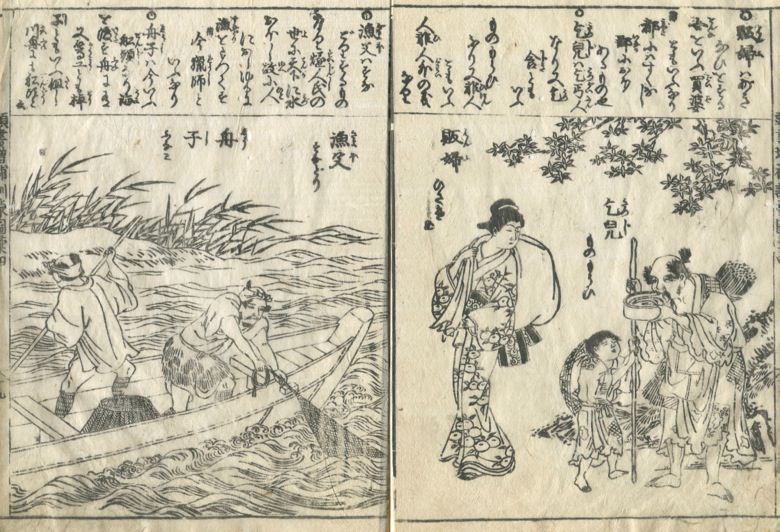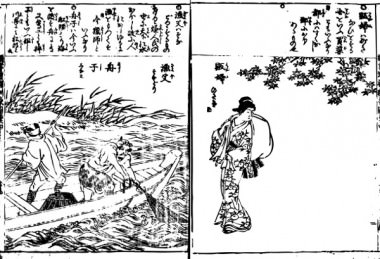A female peddler and beggar are drawn on the right.
“販婦 (Hisagime/Hanfu)” is a woman who does business.
It seems many in the capital.
“乞兒 (Hokai)” means “乞丐人 (Kotugainin)”, and it also calls it a “beggar.”
Although it was an act for practice in Buddhism, it is not told in a meaning good in Japan.
this that time — “a non-person” and “person — it is the outside ” of a non-person, and like withering.
Although each is made into the discriminatory term now, there is value as data, and since it is not its real intention, “there would be nothing” has published.
However, since it judged that there was no meaning used as distribution material, the portion has been deleted.
Please understand the situation.
The fisherman and the captain are drawn on the left.
“漁父 (Gyofu)” is those who catch a fish.
It is said that it is also called a “hunter” although the portions of the origin or relation were not able to be translated.
It is said that “舟子 (FUnako)” was a “captain”, and the ship was floated and manipulated to the sea and it was also called “棹子(Saoko).”
However, in the case of the ship floated on a river, although it seems that it was written as “how that is not carried out” with another Chinese character, it was not able to distinguish.
右には女性の行商人と乞食が描かれています。「販婦(はんふ/ひさぎめ)」とは「あきない」をする女性のことです。都に多かったようです。「乞兒(ほかい)」とは「乞丐人(こつがいにん)」を意味し、「乞食」とも言います。仏教では修行のための行為であったのですが、日本では良い意味では語られません。この当時では「非人」や「人非人外」とかかれる程です。現在ではいずれも差別用語とされていますが、資料としての価値がありますし、「無かった事」にするのは本意ではありませんので掲載しています。しかし、配布素材にする意味は無いと判断しましたので、その部分は削除しています。ご了承ください。
左には漁師と船頭が描かれています。「漁父(ぎょふ)」とは魚を捕る人のことです。由来や関連の部分が訳せませんでしたが、「猟師(りょうし)」とも呼ぶそうです。「舟子(ふなこ)」とは「船頭(せんどう)」のことで、海に舟を浮かべて操り、「棹子(さおこ)」とも呼ばれたそうです。しかし、川舟では別の漢字で「せんどう」と書くようですが、判別できませんでした。

